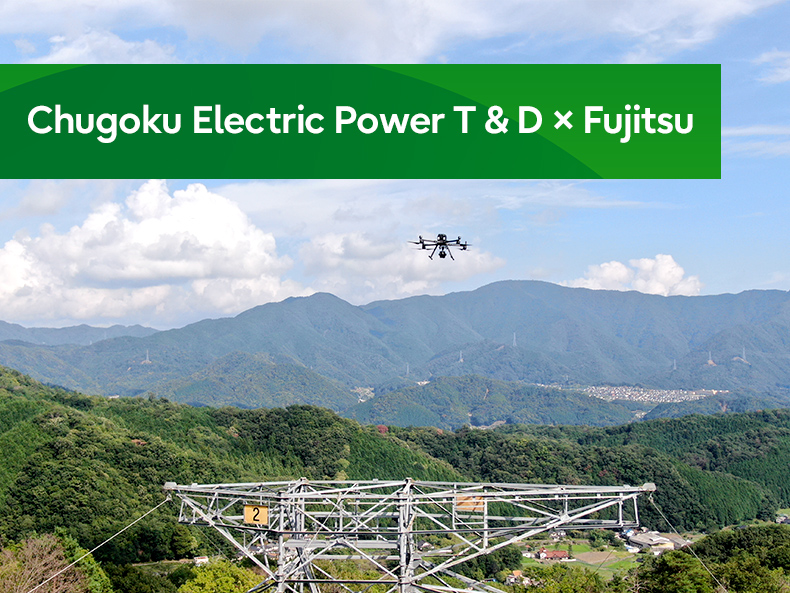- *English translation is based on AI Translation Service ”Zinrai”.
Chugoku Electric Power Transmission & Distribution Co., Inc. (Chugoku Electric Power T & D is described below.) and Fujitsu conducted a demonstration test to expand the use of renewable energy in power transmission facilities and to upgrade transmission and maintenance services. In this article, we introduce the background of the start of the demonstration experiment, the details of the experiment, and the opinions of the people involved in the project.
- Table of Contents
Energy Business Initiatives: Past and Future
At Fujitsu, we have a business brand based on the vision of society in 2030, Fujitsu Uvance has been published. In this article, we introduce our efforts to embody "Digital Shifts," a new data-driven business that is one of the elements that make up Fujitsu Uvance.
To date, Fujitsu has provided energy companies with network products such as IT systems and electricity meters to ensure a stable supply of energy. In recent years, with the liberalization of the electricity retail market, we have supported the competitive environment by constructing front systems such as CRM and contact centers. On the other hand, in addition to our mission of stable supply, we are in an age where we will need to improve our business efficiency and sophistication by utilizing DX technology in order to be carbon neutral. We believe it is necessary to contribute to business innovation and data-driven management by analyzing on-site data with AI and other cutting-edge technologies, and to work together to create a carbon-neutral society.
Against this background, Chugoku Electric Power T&D and Fujitsu conducted demonstration experiments to expand the introduction of renewable energy based on data driven. And the results of the demonstration for about a year, on October 12, 2022, Press Releases and held an online press briefing.

Outline and Results of Demonstration Experiments
Outline of the demonstration experiment
 Overhead ground wires
Overhead ground wires
Overhead ground wires are installed on power transmission lines in order to allow electric current from lightning strikes to escape to the ground, and those with built-in optical fiber cables (*1) are called OPGW. When the OPGW is connected to a dedicated measuring device in the substation, laser pulses (*2) are injected into the optical fiber in the OPGW, and return light is generated in the optical fiber as the laser pulses propagate. The degree of vibration at each position of the OPGW is digitized as vibration data through the calculation of the delay in the return time of the light to the measuring device. (= optical fiber sensing technology) This makes it possible to estimate environmental data (wind conditions). In addition to the obtained environmental data (wind conditions), the temperature of electric wires can be calculated in real time by adding the amount of solar radiation and outside air temperature. For about a year, the Chugoku Electric Power T & D and Fujitsu conducted verification tests on three transmission lines owned by the Chugoku Electric Power T & D in the Chugoku region to see if the technology could be applied to actual operations.
- *1Optical fiber: Optical fiber for communication to transmit information
- *2Laser pulse: Light that flashes repeatedly at fine time intervals
1. Drones can fly safely by estimating environmental data (wind conditions) around power lines
In this demonstration, we estimated the environmental data (wind conditions) between each steel tower using the optical fiber sensing technology described above. The red arrow in the lower left image shows the environmental data (wind conditions) between each steel tower, and it can be confirmed that the area around the electric wires can be grasped in detail for about 70 km. In the graph at the lower right, the orange line shows the data converted from the vibration information of the optical fiber, and the blue line shows the data acquired by the anemometer actually installed in the steel tower.

Currently, workers at the Chugoku Electric Power T & D are climbing up to the power line towers to inspect transmission lines, and patrolling by helicopters, vehicles, and walking. In the future, we are considering replacing these tasks with drones. However, since the flight of a drone is greatly influenced by the wind, it is necessary to accurately grasp the environmental data (wind conditions) such as wind velocity in real time in order to fly a drone far away. By utilizing this technology, it was possible to accurately and efficiently grasp the situation even in mountainous areas where wind conditions are complicated by ups and downs, and it was verified that this technology could be applied to the decision of whether to fly a drone or not and the selection of flight routes considering wind conditions.
2. Increase transmission capacity by estimating transmission temperature in real time
The temperature of power transmission lines is affected by the ambient environment, such as outside air temperature and sunlight, in addition to the power transmission current, but the cooling effect due to wind conditions has the greatest impact. In the verification this time, we estimated the temperature of transmission lines by combining environmental data (wind conditions) measured with Fujitsu technology, open data on outside temperature and solar radiation, and current values owned by transmission and distribution companies. The figure below shows the estimated results. The blue line is measured by a thermographic camera and the orange line is estimated. The temperatures are roughly the same.
 Comparison of measured and estimated transmission line temperatures
Comparison of measured and estimated transmission line temperatures
Currently, for safety reasons, the Chugoku Electric Power T & D operates power lines with a fixed upper current limit. By utilizing this technology, it is possible to accurately grasp the state of transmission lines in real time, and it can be applied to Dynamic Rating, a technology that flexibly operates current flowing through transmission lines according to the situation.
In general, to increase transmission capacity, it is necessary to build new steel towers and increase the thickness of electric wires, which costs several hundred million yen per kilometer and takes several years (*3). Since dynamic rating is a system enhancement technology that makes effective use of existing facilities, it is expected to have a high effect with a short lead time compared to the construction of new steel towers and the use of thicker wires.
- *3According to the unit price announced by the Organization for the Promotion of Wide-Area Operations of Electric Power in 2016, approximately 1 ~ 1,000,000,000 yen per kilometer is required for the construction of transmission lines. The construction of transmission lines involves route selection, site acquisition, design, and construction, and requires lead time in multiyear units.
3. Creating a prototype system for practical use
We have also developed a prototype system that combines the wind speed, wind direction, and transmission capacity estimated from the vibration data of optical fiber, the tower route owned by the power transmission and distribution company, the current value of the transmission line, the amount of solar radiation, and the outside air temperature to visualize the system. By using this system in actual operations, power distribution companies will be able to support the advanced operation of the transmission network, which covers both the aforementioned drone operation support and dynamic rating.

Toward a Carbon Neutral World
――Why did Fujitsu and the Chugoku Electric Power T & D join forces?
Mr. Hirahara: It all started when Fujitsu introduced us to optical fiber sensing technology. Our company was considering the introduction of dynamic ratings and the use of drones to address issues such as the increasing social demand for the introduction of renewable energy and the shrinking working population. In both cases, the wind conditions in the vicinity of power lines play an important role, so we were looking for an efficient and accurate method. By using optical fiber sensing technology, we can obtain environmental data (wind conditions) in the vicinity of transmission lines over long distances using the same index, without the need for external power supplies or telecommunications infrastructure. In fiscal 2021, we began studying the application of this system to dynamic ratings and support drone operations. From fiscal 2023 onward, we aim to commercialize it as soon as possible.
――What did you want to verify the most in the demonstration experiment?
Mr. Hirahara: Verification of estimation accuracy. The goal of this technology is to apply the estimated environmental data (wind conditions) to dynamic rating and drone operation support, so maintaining a certain level of accuracy is a prerequisite for using this technology. For this reason, we discussed and decided with Fujitsu how to verify the estimation accuracy, including the type and location of measuring instruments to be installed at the site. By communicating closely with Fujitsu and repeating the cycle of identifying issues for commercialization → verification → examination of solutions to issues found in the verification results, we believe we have achieved results that exceed our expectations in a short period of time.
――Please tell us about your commitment and ingenuity to facilitate the project.
Fukuda: I thoroughly discussed with Chugoku Electric Power T & D how Fujitsu's optical fiber sensing and data conversion technologies can be used to enhance the maintenance of transmission facilities, and I was conscious of the goal. For example, there is a verification that improves the accuracy of data for operation, but I think that sometimes higher accuracy than necessary is required. However, this time, we discussed that it would be better to keep the accuracy necessary and sufficient for the operation and to devote resources to verification from a different viewpoint. I think it was good that all of us could prioritize including the accuracy of data for operation.
――How do these activities lead to the expansion of the use of renewable energy?
Uno: In order to conserve energy, it is important to use renewable energy as much as possible so that it is not discarded. However, if a large amount of renewable energy is received when there is no wind or when there is a slight wind, there is a problem that the transmission lines become too hot, so the current situation is that the acceptance of renewable energy is restricted. Therefore, if we can comprehensively grasp how nature cools transmission lines, we can optimize (improve efficiency) the instructions for power generation to power plants and the acceptance of renewable energy into transmission lines. I hope that this will lead to an increase in the use of renewable energy.
――Expectations are growing for a sustainable world.
Fukuda: Yes. The primary objective of the demonstration is to improve the quality of the power grid maintenance business by using technology, but as we continue to discuss this with our customers, we may come up with solutions to problems that we have not been able to solve before. Technology can be used in a variety of ways and possibilities for a sustainable future. Looking closely at the results of this demonstration, we will continue to confront our customers and propose the use of technology to lead to a sustainable world.
 Left: Naoya Hirahara, Technical Advancement Group, Network Equipment Department, Chugoku Electric Power Transmission & Distribution Co., Inc.
Left: Naoya Hirahara, Technical Advancement Group, Network Equipment Department, Chugoku Electric Power Transmission & Distribution Co., Inc.Right: Uno Kazushi, Digital Shifts Data Platform Business, Uvance Unit, Global Solutions Business Group, Fujitsu Limited
 Kanako Fukuda, Chugoku Utility Business Dept, Utility Business Division,
Kanako Fukuda, Chugoku Utility Business Dept, Utility Business Division,Social Systems Unit, Fujitsu Limited
Related Information
- [Press Releases] Fujitsu and Chugoku Electric Power T & D conduct joint trials to expand use of renewables and improve maintenance of power transmission facilities
- [Chugoku Electric Power T & D Press Releases] Chugoku Electric Power T & D and Fujitsu conduct joint trials to expand use of renewables and improve maintenance of power transmission facilities (in Japanese)




